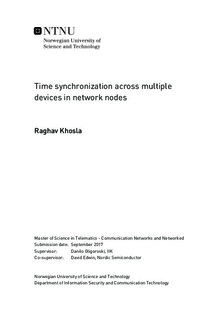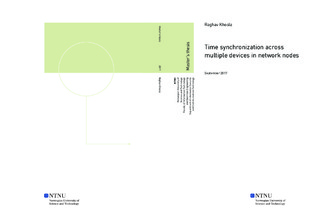| dc.description.abstract | Effective time synchronization has become a critical issue nowadays, especially where loads of confidential data needs to be transferred via a medium from one point to another. Rapid advancements in technology have paved the way for the design of low-power networks/wireless solutions, for instance, Wireless Sensor Networks, and more.
Sensor networks, being a collection of a large number of interconnected nodes communicating with each other need to prioritize effective synchronization of data as well as time between message exchanges. A commonly stated fact being that the local clocks at the different nodes within the network are continually drifting apart in real time. In an effort to counterattack the drift and offset, precise timestamping needs to be done. This won t eliminate the drift but one expects that more accuracy can be attained while sampling multiple events taking place in the network. Considering the fact that if there is lack of coherence in the events taking place in such networks, such that there is no account of an event being generated and/or terminated, then it is difficult to assure the receipt of the data at the desired location at a particular instant of time.
The report highlights two earlier proposed algorithms for synchronizing time across sensor networks, namely Tiny-Sync and Mini-Sync. Certain loopholes are investigated in the proposed hypothesis and assumptions as well as conclusions drawn from these algorithms.
The entire thesis work focuses on timing synchronization across multiple devices in broadcast mesh type networks. Two separate cases have been brought about. One is synchronizing time between neighboring nodes (single hop) and the other being time synchronization among distant nodes (multi-hop). nRF Radio functionality as in the standard nRF51 specification will be used over BLE stack as the medium for sending/receipt of data packets between the different nodes. All this would be done using 16 MHz/32.768 kHz XOSC with a cheap quartz crystal as the reference sources. The local clocks at the corresponding nodes need to be frequency and phase locked(using a Phase Locked Loop(PLL))with each other in order to be precisely matched with respect to each other. For this certain protocols/algorithms will be demonstrated for modeling the drift, offset, and other factors crucial for stability. Effective timestamping at each of the transmit/receive points is key to obtain precise estimates on the desired variations. Once the timestamps are generated, these will be used to derive certain mathematical, and graphical results taking
the relative drift between the node clocks due to temperature and other factors, as well the relative offset into account.
The Saleae Logic Analyzer tool will also be used to interpret the time durations (delays) between the defined Radio events as the packet is being transmitted/received.
Further, Segger J-Link RTT Viewer will be used for real time analysis of the captured timestamp values within the transmitted packets.
In addition to this, relevant conclusions will be drawn on the accuracy of synchronization achieved via practical analysis using the embedded software solution designed.
The project work would also address the weak points observed in the stated algorithms from the practical analysis done in an attempt to validate the core idea behind time synchronization in similar networks. | |

